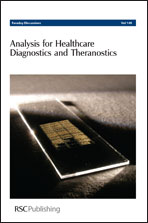Nucleic acid aptamers: ideal reagents for point-of-care diagnostics?
Abstract
Nucleic acid
aptamers have many of the properties that make for effective reagents in point-of-care diagnostic devices and whilst superficially similar to antibodies as affinity reagents the scope for engineering them to fit this role is considerable. Synthesis of aptamers allows for the incorporation of functionality for both immobilisation and electrochemical signalling in a way that is compatible with the ‘strip’ type sensors familiar in enzyme sensors, such as those for
- This article is part of the themed collection: Analysis for Healthcare Diagnostics and Theranostics

 Please wait while we load your content...
Please wait while we load your content...